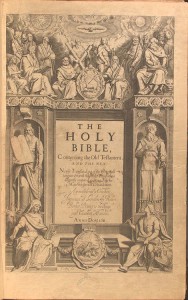Food for thought on the translation of the English Bible…
Mormons have 13 Articles of Faith which are similar to creeds in other religions. In the 8th Article of Faith it is stated “We believe the Bible to be the word of God as far as it is translated correctly.”
Although much attention has been given to this statement, Mormons still accept as canon the Authorized King James Version (KJV) of the Bible. This same Bible is also accepted as canon by many Protestants. A fair question is– Why would the Mormon religion embrace this statement if they accept the KJV as scriptural canon?
 A quick visit to a Christian bookstore will reveal that there are, at least, a dozen, and perhaps two dozen different translations of the Bible at any given time. The question then becomes why are there so many translations and why are they needed? There are a number of reasons new translations of ancient scriptures are needed. One most often overlooked is that a language is a living thing.
A quick visit to a Christian bookstore will reveal that there are, at least, a dozen, and perhaps two dozen different translations of the Bible at any given time. The question then becomes why are there so many translations and why are they needed? There are a number of reasons new translations of ancient scriptures are needed. One most often overlooked is that a language is a living thing.
Whenever a translator considers making a translation, he must make hundreds and even thousands of decisions that affect the final outcome of the specific translation. A key goal of translators is to render the translation in a way that does not violate the spirit or intent of the original writer. This is a tricky proposition because it implies the translator must have a feel for the purpose and intent of the writer.
Inspired Translation
Most believers take for granted that the biblical translator is inspired and works under the direction of the Holy Spirit. From a reader’s perspective, the scriptures must also be read and interpreted within the prism of faith and the initial basis of interpretation is what the biblical translator has interpreted the purpose and intent of the writer of a holy manuscript. A second goal of a translator is to render a translation that fully reflects the genius of the writer in the original language and then to transfer that genius into the target language.
In English, there is no agreement as to what constitutes proper and improper English. Americans have their own version of English and do not look to their British counterparts for confirmation of proper and improper English usage. What constitutes proper English usage is in a state of constant flux based on popular or technical usage. There are few arbitrators in the area of what constitutes proper English usage except in professional circles. Ultimately, it is up to the speaker and hearer to decide what the practicality and usage is understandable and acceptable. Later, dictionaries, both professional and popular, add new usage, long after a new convention has established itself in the language. Thus, modern English is not as uniform or constant as some other languages.
____________________
In this article I have shared some observations on the translation of the English Bible with the goal of explaining my perspective on Biblical translations.
I have used the Lord’s Prayer (Mathew 6: 9-13) because it is universal in Christianity and well recognized by most Christians– both as a recited prayer and as a template or model for personal prayer.
I have not quoted Biblical translations in English prior to those cited because the ancient English language is a medley of provincial Latin, Celtic, Saxon, Welsh, Erse, Danish and Norman- French. Additionally, modern English has adopted additional words from various modern languages. Other words are borrowed and appear in their original language, but are simply used in modern English and the meaning is understood.
Many earlier translations of the Bible scarcely even resemble modern English today. However, I do have purpose in illustrating the plausibility and evolution of Biblical English translations.
Here is a translation of the Lord’s Prayer from about 1160 A.D. during the reign of England’s King Hendry II.
Ure fadyr in heaven rich,
Thy name be hallyed ever lich,
Thou bring us thy michell blisse:
Also hit in heaven y doe,
Evar in yearth beene also.
That holy bread that lasteth ay,
Thou send it ous this ilke day,
Forgive ous all that we have don ,
As we forgivet uch other mon:
Ne let ous fall into no founding,
Ac shield ous fro the fowle thing Amen
This particular translation was put to rhyme. It would be highly unusual for anyone to speak in rhymes. The first exemplar was sent from Rome by Pope Adrian who was himself and Englishman. Next, a mere 90 years later, taken during the reign of England’s King Hendry III in about 1250 A.D.
Fadir ur that es in hevene,
Halud be thi name to nevene:
Thou do us thi rich rike,
Thi Will erd be wroght elk:
As it is wroght in Heven ay,
Ur ilk Day Brede give us to Day:
Forgive thou all us dettes urs
As we forgive till ur detturs
And ledde us in na fanding
But sculd us fra ivel Thing.
Now let us jump forward in time to the year 1610 A.D., in the time of James I– in Barker’s London Bible…
Our Father which art in Heaven hallowed bee thy Name. Thy Kingdom come. Thy will bee done even in earth as it is in Heaven.
Give us this day our daily Bread and forgive us our Dettes, as wee also forgive our Detters.
And leade us not into Temptation but deliver us from evil: for thine is the Kingdom, and the power and Glory for ever. Amen.
There are some notable features we should acknowledge. Specifically, the first two versions are written and versed like poetry and the third, although not as modeled in a poetic way, is still poetic. Secondly, the arrangement of the verses is slightly different and punctuation and spelling by today’s standards is highly irregular.
On the translation process… the use of machine translations
 In today’s world of translations –quite often translators will do a preliminary translation using a machine translator or software program. The professional translation software allows the translators to make many of the decisions needed with regard to the translation before they run the text through the program.
In today’s world of translations –quite often translators will do a preliminary translation using a machine translator or software program. The professional translation software allows the translators to make many of the decisions needed with regard to the translation before they run the text through the program.
Some of the decisions that are made might be the tense, type of words, and have to do with how the rough or “dumb” translation will occur. Depending on the field of study for the translation, a series of special dictionaries are used to translate technical terms. These specialized dictionaries work in a similar fashion to a spell checker in a word processing program. Additionally, the development of these machine translations cannot occur without years of highly specialized work by translators compiling the dictionaries.
Many people are familiar with machine translations because simple translations are often used on the internet or intranet in business when conducting business with foreign nationals in various countries. Additionally, many people use these machine translators to communicate with family and friends in many foreign languages.
Notwithstanding, a basic understanding, these machine translations leave much to be desired and sometimes are even silly from the perspective of native speakers. Moreover, the translations still require the human touch to make them clearly understood. After the machine translation program is run, a professional translator or native speaker still needs to tweak the text so that it makes sense.
Scholars and linguists considering translations of Biblical type text most often translate from Hebrew, Aramaic and Greek. Biblical texts also require careful scrutiny and are affected by the continuing discovery of new finds and new texts– thus keeping translation possibilities in a constant state of flux as our understanding improves of ancient culture and languages improves. Thus, even ancient languages, perhaps, even dead languages, are in a historical sense still living. Moreover, a religious text can be more difficult than many scientific fields because there is so much material and interpretations dating back to Old and New Testament times and so many disagreements through the centuries.
With biblical texts, in addition to the goals of the translators, theologians set an even higher bar by requiring theological clarity. For illustrative purposes, let us consider Isaiah 7:14 since it has been the subject to hot debates and vigorously disputed among translating linguists, scholars, and theologians.
The authorized King James Version (KJV) used by most Protestants and members of The Church of Jesus Christ of Latter-day Saints (Mormons) states the scripture as “Behold a virgin shall conceive, and bear a son, and shall call his name Immanuel.” Several other bibles, including the NAB (New American Bible) translated the texts as “The virgin shall be with child, and bear a son, and shall name him Immanuel.”
The Hebrew translation has a word that is equivalent to “young woman.” It is tricky because in Hebrew there is a separate word for Virgin. Several bibles, including the NRSV (New Revised Standard Version) read “the young woman shall bear a son, and shall name him Immanuel.” It may initially seem as if we are parsing words, but it is theologically important to make a distinction as to whether Mary, the mother of Jesus was a virgin, rather than merely a young woman. In Saint Mathew’s Gospel which was translated from the Greek –the specific word “virgin” is used.
 Further complicating the situation for many Christians is that the books of the Bible were not designated specifically as the Bible until the Council of Trent in 1546. The Church fathers accepted forty-six Old Testament books they believed were part of a firm tradition in ancient Christianity.
Further complicating the situation for many Christians is that the books of the Bible were not designated specifically as the Bible until the Council of Trent in 1546. The Church fathers accepted forty-six Old Testament books they believed were part of a firm tradition in ancient Christianity.
The Protestant reformers rejected some of the books chosen by the Council of Trent. The seven books rejected by our Protestant fathers were are Tobit, Judith, Wisdom, Sirach, Baruch and 1 & 2 Maccabees. These books are canonized in Catholic Bibles, but are omitted in Protestant bibles. Additionally, there are some sections of Daniel and Esther that Protestants do not consider to be inspired.
All of these factors figure into the need for correct translations. We can easily see from the cited material that correct translations are a challenge. Even Christians who take Biblical text literally as a perfect book need to consider that the translators of biblical languages and texts are not perfect even though they are accomplished under the inspiration of the Holy Spirit. This is one of the reasons there is so much disagreement theologically and academically among individual hearers, theologians and scholars.
In addition to all of these discrepancies, translators need to correct and properly punctuate biblical texts periodically in keeping with the goal of theological clarity. My point is that, although there may be discrepancies in biblical translations, we should not take biblical translations down to the very word as a perfectly written record. Any inconsistencies should be attributed to the foibles of men and we should always keep in mind that our interpretation should be done through the prism of faith and through the inspiration and guidance of the Holy Spirit.
Bibliography
Borup, Mel. World Alphabets (original title: Pantographia). Reprint Ogden Utah 1986.
